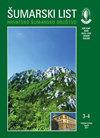斯科普里林业学院树木公园树木的健康状况,特别关注真菌疾病和害虫
IF 0.4
4区 农林科学
Q4 FORESTRY
引用次数: 0
摘要
北马其顿斯科普里林业学院的Dendropark是一个“户外博物馆”,收藏了森林树木和灌木植被。该藏品于1950年种植,占地4.05公顷,包括336个分类群,来自马其顿和巴尔干地区特有的石斛植物和来自世界各地的引进物种。像世界上其他植物园一样,树篱公园提供了一种独特的资源,有助于早期发现对森林树种的潜在入侵威胁。共有43科444棵树。最具代表性的3个科是松科(21种)、柏科(16种)和蔷薇科(18种),分别占已调查植物的19.4%、15.8%和7.4%。2014年的调查显示,33.8%的树木健康状况良好,1.8%的树木健康状况很好,31.1%的树木健康状况一般,24.5%的树木健康状况较差。大约4.1%的树木被评为处于危急状态(处于下降状态),4.7%的树木死亡。对Dendropark植物健康状况的评估可作为规划人员和决策者的宝贵资产,并提供有关城市地区自然资源的质量、数量和位置的信息。确定植物物种组成的变化和入侵性病虫害的存在有助于维持健康的城市森林。本文章由计算机程序翻译,如有差异,请以英文原文为准。
The health condition of trees in dendropark at Faculty of Forestry – Skopje with a special focus on fungal diseases and insect pests
The Dendropark at the Faculty of Forestry in Skopje, North Macedonia, was established as an ‘outdoor museum’ with a collection of forest trees and shrub vegetation. The collection was planted in 1950 on the area of 4.05 ha, and includes 336 taxa from native Macedonian and Balkan endemic dendroflora and introduced species from around the world. The Dendropark, like the other botanical gardens all over the world, offers a unique resource that facilitate earlier detection of the potential invasive threats to forest tree species. The inventoried population includes 444 trees belonging to 43 families. The three most represented families are Pinaceae with 21 species (19.4% of the inventoried plants), Cupressaceae with 16 species (15.8%) and Rosaceae with 18 species (7.4%). The 2014 survey indicated that 33.8% of the total number of trees were rated with good health status, 1.8% as very good, 31.1% rated as fair, while 24.5% were poor. Approximately 4.1% were rated to be in a critical state (in a state of decline), and 4.7% of trees were dead. The assessment of health status of plants in the Dendropark could be used as a valuable asset to planners and decision makers and provides information about the quality, quantity and location of natural resources in urban areas. Identifying changes in plant species composition and presence of invasive pests and diseases helps maintaining healthy urban forests.
求助全文
通过发布文献求助,成功后即可免费获取论文全文。
去求助
来源期刊

Sumarski List
FORESTRY-
CiteScore
0.90
自引率
20.00%
发文量
32
审稿时长
>12 weeks
期刊介绍:
Forestry Journal publishes scientific and specialist articles from the fields of forestry, forestry-related scientific branches, nature protection and wildlife management.
 求助内容:
求助内容: 应助结果提醒方式:
应助结果提醒方式:


